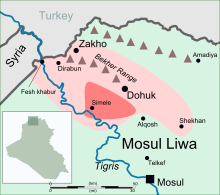Semile massacre
In the Semile massacre ( Syriac-Aramaic : ܦܪܡܬܐ ܕܣܡܠܐ or ܦܪܸܡܬܵܐ ܕܣܡܹܠܹܐ Premta d-Simele ) several thousand Assyrians were murdered in various villages in northern Iraq in 1933 . The particularly affected village of Semile gave its name.
background
In 1933 the British League of Nations mandate in Iraq ended and a group of Assyrians negotiated with the French to find admission for their families in Syria . About 800 men appeared on the Chabur River , on the recently established border between Syria and Iraq. The French judged the border crossing to be illegal and all the men were sent back. On the Iraqi side, there was then a clash with government troops who had taken up positions there. 530 Assyrians fled back to Syria and were interned there. The Assyrians / Arameans captured by the Iraqi forces were killed.
The massacre
The border incident and the pent-up aggression against the Assyrians led to the so-called Semile massacre in 1933. It was rumored that the Assyrians were plundering northern Iraq among the Iraqi people. This made it possible to turn Kurdish and Arab tribes against the Arameans / Assyrians. In the wake of the unrest, 60 out of 64 Assyrian villages were destroyed and, under the leadership of the Iraqi military , the Assyrians were rounded up and males over the age of ten were shot. In Semile, there was a massacre by the Iraqi troops, which in Iraq was understood and celebrated as the end of the Assyrian uprising. For Semile alone, 350 killed are named, the total number of Assyrians who died is estimated at over 9,000.
The Patriarch, Mar Shimun XXIII. , who was held in Baghdad, tried again and again to inform the diplomatic missions and the League of Nations about the dramatically escalating events through petitions.
literature
- Sargon George Donabed: Reforging a forgotten history. Iraq and the Assyrians in the Twentieth Century . Edinburgh University Press, Edinburgh 2015, ISBN 978-0-7486-8602-5 .
- John Joseph: The Assyrian Affair: A Historical Perspective . In: International Journal of Middle East Studies , Vol. 6 (1975), pp. 115-117.
- John Joseph: The modern Assyrians of the Middle East. Encounters with Western Christian missions, archaeologists, and colonial powers . Brill, Leiden 2000, ISBN 90-04-11641-9 .
- Ivan Kakovitch: Mount Semele . Mandrill, Alexandria, VA 2002, ISBN 1-931633-70-3 .
- Alexander Mikaberidze (ed.): Atrocities, massacres, and war crimes. To encyclopedia . ABC Clio, Santa Barbara 2015, ISBN 978-1-598-84925-7 , Vol. 2, pp. 733-766: Chronology of massacres and war crimes , here p. 746.
- Ronald Sempill Stafford: The Tragedy of the Assyrians . Allen and Unwin, London 1935.
- Abdo Mirza, Franz-Rudolf Müller: "We came to the Chabour barefoot, we are forced to walk again barefoot". Lit Verlag, Berlin / Münster 2019, ISBN 978-3-643-14320-4
Individual evidence
- ↑ Keith David Watenpaugh: Bread from Stones. The Middle East and the Making of Modern Humanitarianism . University of California Press, Berkeley 2015, ISBN 978-0-520-27932-2 , pp. 195-196.
- ↑ Wilhelm Baum , Dietmar Winkler: The Apostolic Church of the East. History of the so-called Nestorians . Kitab publishing house, Klagenfurt 2000, ISBN 3-902005-05-X , p. 126.
- ^ FIDH Report: Iraq: continuous and silent ethnic cleansing. Displaced persons in Iraqi Kurdistan and Iraqi refugees in Iran
- ↑ Martin Tamcke: Hermannsburg, the Assyrian question and the League of Nations . In: Georg Gremels (ed.): The Hermannsburg Mission and the "Third Reich". Between fascist seduction and Lutheran perseverance. Lit, Münster 2005, ISBN 3-8258-8972-6 , pp. 151–166, here p. 160.
- ↑ Sargon Donabed George: Reforging a forgotten history. Iraq and the Assyrians in the Twentieth Century . Edinburgh University Press, Edinburgh 2015, pp. 109-122.
